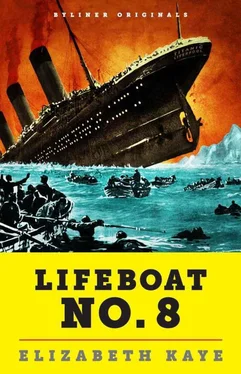Mrs. Taussig, Mrs. Kenyon, and Mrs. Wick were frantic as they scanned the decks for their husbands, but they were three of the reasons the Carpathia had already been dubbed “the ship of widows.” Another widow was the young bride, Maria Peñasco.
In the course of the morning, Mrs. Bucknell met up with Molly Brown, who had laughed at her several days before when she said she had “evil forebodings” about the voyage.
“Didn’t I tell you?” Mrs. Bucknell exclaimed. “I knew it.”
The sun was still rising when the Carpathia ’s engines started up again, while high above the crowded deck, her house flag flew at half-mast. Can a ship move in a dignified manner? If so, the Carpathia was supremely dignified as she headed slowly toward the Titanic ’s last position in search of any possible survivors. As they approached the site of the sinking, the Countess, Gladys, and Roberta stood at the rail, taking in the extraordinary sight: ice floes as far as the eye could see, and a field of icebergs—glassy, defiant, towering peaks standing up to two hundred feet high, glistening in the harsh morning light.
The Carpathia threaded its way through the ice until it reached the spot where, two and a half miles below, the Titanic lay in pieces on the ocean floor. There were no survivors to be found, only bits of wreckage. Caroline leaned over the rail and saw a man’s glove and a baby’s bonnet floating on the water.
As the Carpathia headed toward New York, the Countess sent Roberta to the wireless shack with messages for her parents and husband. There, helping the Carpathia ’s operator, was Harold Bride, the Titanic ’s assistant operator. His ankles, possibly broken, were swathed in heavy bandages, and his eyes were as dark and deadened as the tips of matchsticks whose flames had been blown out. It was from Harold that Roberta learned what had become of Jack.
After the sinking, Jack had clung to the same overturned boat that Harold held on to, a boat that had gone into the water upside down and become the refuge of the fifteen or so crew members who managed to reach it. Did Jack feel that he had failed when he heard the cries of the dying? We will never know. What can be said is that his hopes seemed to be high as he speculated, throughout the night, about ships—in addition to the Carpathia —that might be on the way. He had sent distress messages to ten ships in all, among them the Olympic, the Baltic, the Virginian, the Mount Temple, the Celtic, and the Asian, and he was certain that at any moment one of them—or perhaps all—would come to save the few who were still living.
But Jack Phillips had been “all done in” before the crisis occurred. At some point before the dawn broke, his heart gave out, and his voice was no longer heard.
“He was a brave man,” said Harold. “I learned to love him that night.”
The Carpathia ’s passengers collected clothes for the survivors, many of whom preferred to remain in the dressing gowns and suits and cloaks they had been wearing when they came away from the Titanic, as if, by so doing, they could reverse time and return to life as it had been.
At night, the men slept on the smoking-room floor or on the decks while the women were given straw mattresses set side by side on the floors of the saloons and the library. The exceptions were Mrs. Astor, who remained cloistered in a suite a passenger had vacated for her, and Bruce Ismay, the chairman and managing director of the White Star Line, who also was given a suite and enough opiates to keep him sedated.
All but four of the 144 first-class women had been saved, along with three of the four children, but only 57 of the 175 men. The numbers were even grimmer in second class, where all 25 children survived but death had come to 13 of the 92 women and 135 of the 152 men; third class had lost 91 of 179 women, 55 of 80 children, and 381 of 440 men. These incontrovertible figures meant that days and nights aboard the Carpathia were filled with unquenchable grief and sobbing and praying.
Makeshift hospitals were set up in each of the Carpathia ’s three dining rooms. There, English doctors attended first-class passengers; Italian doctors took care of passengers from second class, and Hungarian doctors cared for those who traveled in steerage. The Countess of Rothes and Gladys Cherry set aside their own sorrow by assisting them as they tended to the men, women, and children Gladys described as “these poor distressed souls.”
The Countess was one of few upper-class ladies to be trained as a nurse, which qualified her to apply braces and bandages and administer medications. Of the 908 crew members, 713 had been saved, and she gave special attention to those among them who had had to swim away from the ship and whose legs and feet were still frozen. “Our Titanic men are amazing,” Gladys exclaimed, “when you think of all they have been through.”
The two women also comforted children from steerage and second class, most of whom had lost at least one parent. Many had nothing to wear, so they cut up spare blankets and linens to fashion leggings and coats for them.
By the end of that first day on the Carpathia, the ship’s crew was marveling at the woman they dubbed “the plucky little Countess.”
“You have made yourself famous by rowing the boat,” a stewardess told her.
“I hope not,” the Countess said. “I have done nothing.”
Many women aboard the Carpathia were sustained only by the blind, unavailing hope that their missing men would be returned to them. “Oh, if I only knew,” they would say, “whether my husband has been saved.”
Caroline Bonnell harbored no such illusions. Her cable to her mother, who awaited word of her fate and that of her cousins Natalie, Mollie, and George Wick, was blunt and to the point: “All women saved… George lost.”
As Caroline lay on her straw mat, surrounded by suffering, one discomfiting thought came repeatedly to mind: To think that Natalie and I wished to see an iceberg all the way over .
After three days at sea, the Carpathia finally reached New York Harbor. In a cable to her parents, the Countess echoed what must have been the sentiments of every Titanic survivor. “At last I am safe and sound. Am resting, I am so tired. Thank God I am here.”
Two days after the Carpathia docked, the steamship Bremen was advancing through the North Atlantic Ocean when passengers were told they were within a few miles of the Titanic ’s last position. Soon an iceberg was sighted off the bow to starboard. It was, said the Bremen ’s officers, most probably the iceberg that had doomed the great ship, so everyone ran to see the luminescent, intractable mountain of ice beaming absurdly in the late-day sun.
As the Bremen moved on, it passed through the southernmost drift of the wreckage, and the excited, chattering passengers looked down into the water and fell silent.
Floating near them was the corpse of a woman in her nightdress clasping a baby to her breast. Nearby were the bodies of three men clinging to a steamer chair, and the body of another woman holding tight to one of the many dogs that had been brought aboard the Titanic. This one, it appeared, was a Saint Bernard.
Further away, they could see white cork-filled life belts bobbing on the water. There were bodies in them: the frozen human detritus of what was now—officially—history’s most devastating maritime disaster.
When the passengers of Lifeboat No. 8 returned to land, their story did not end. For as long as there were survivors their saga would continue. The difference was that on the sea they had been subject to a common fate, while on land each would become enmeshed in private grief, in private narratives.
Читать дальше












